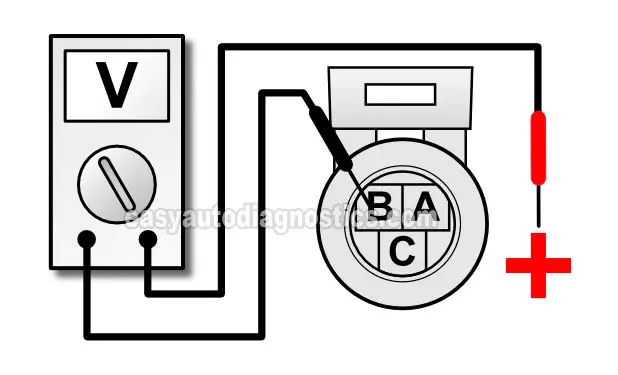TEST 2: Making Sure The TPS Is Getting 5 Volts

The throttle position sensor (TPS) on your 3.2L Isuzu Amigo (Rodeo, Trooper, Honda Passport, etc) needs power to work. This power comes in the form of 5 Volts DC from the fuel injection computer.
The test in this section will help you to confirm if these 5 Volts are present or not.
The wire that feeds these 5 Volts to the throttle position sensor is the wire that connects to the terminal labeled with the letter A in the illustration above.
This is what you'll need to do:
- 1
Place your multimeter in Volts DC mode.
- 2
Disconnect the TPS from its electrical connector.
- 3
Connect the red multimeter test lead (with the appropriate tool) to the terminal labeled with the letter A in the image above.
NOTE: If you probe the front of the connector, be careful not to damage the female terminal. - 4
Connect the black multimeter test lead directly on the negative (-) battery terminal.
- 5
Have a helper turn the key on, but don't start the engine.
- 6
The multimeter should display 4.5 to 5 Volts.
Let's see what your multimeter test result means:
CASE 1: The multimeter registered 4.5 to 5 Volts. This is the correct test result and it confirms that the fuel injection computer and the wire is supplying the TPS with power.
The next step is to test the Ground circuit of the throttle position sensor, TEST 3: Testing The TPS Ground Circuit.
CASE 2: The multimeter DID NOT register 4.5 to 5 Volts. This test result tells you that the computer or the circuit are NOT providing the voltage that the TPS needs to operate. The two most likely reasons for this are: 1) an open-circuit problem in the wire or 2) the PCM may be fried.
Altho' it's beyond the scope of this article to test these two conditions, you have now eliminated the throttle position sensor (TPS) on your 3.2L Isuzu or Honda as being the cause of the problem and/or the TPS diagnostic trouble code (DTC) lighting up the check engine light (CEL).
TEST 3: Testing The TPS Ground Circuit

So far you have verified that the TPS is not creating a throttle position signal (TPS TEST 1) and that the TPS is getting power (TPS TEST 2). The second step, before condemning the throttle position sensor, is to verify that it also has a good Ground.
The PCM is the one that provides this Ground internally, so be careful and don't accidentally or intentionally apply power (12 Volts) to this circuit or you'll fry the PCM. OK, here are the test steps:
- 1
Place your multimeter in Volts DC mode.
- 2
Disconnect the TPS from its electrical connector.
- 3
Connect the black multimeter test lead (with the appropriate tool) to the terminal labeled with the letter B in the image above.
NOTE: If you probe the front of the connector, be careful not to damage the female terminal. - 4
Connect the red multimeter test lead directly on the positive (+) battery terminal.
- 5
Have a helper turn the key on, but don't start the engine.
- 6
The multimeter should display 10 to 12 Volts.
Let's check out what your multimeter test result means:
CASE 1: The multimeter showed 10 to 12 Volts. This is the correct test result and confirms that the PCM and the wire/circuit (that supply this Ground) are OK.
This multimeter test result also confirms that the TPS sensor is bad and needs to be replaced only if:
- You have confirmed the TPS is not producing a voltage signal that increases/decreases as you open/close the throttle plate (TEST 1).
- You have confirmed that the TPS is receiving 5 Volts (TEST 2) and Ground.
CASE 2: The multimeter DID NOT show 10 to 12 Volts. This result eliminates the TPS as bad and probably indicates a problem with either the PCM (internal fault/problem) or an open-circuit problem in the wire between the TPS and the PCM itself.
Altho' testing these two conditions are beyond the scope of this article, you have now eliminated the throttle position sensor (TPS) on your 3.2L Isuzu or Honda as being the cause of the problem and/or the TPS diagnostic trouble code (DTC) lighting up the check engine light (CEL).
TPS Code Won't Go Away

So you've tested the throttle position sensor (TPS) and according to the test results, the TPS is good. But the check engine light keeps coming back on even after you erased the diagnostic trouble code (DTC) from the computer's (PCM) memory. Well, here are a couple of suggestions that might inspire your next diagnostic move:
- The throttle plate idle-stop screw (see photo above) has been adjusted so that the engine could be idled up and mask a miss/misfire and/or rough idle. This increases the TP sensor's signal to the PCM. The PCM doesn't like it and lights up the check engine light (CEL).
- The throttle cable is binding and causing the throttle plate to not fully close.
- This can be verified by simply having someone inside the vehicle pushing the accelerator pedal to the floor and releasing it, with the engine OFF, while you visually check that the throttle plate and cable are not getting stuck somewhere in their travel.
- The TPS is failing intermittently. Which means that it works fine most of the time, but every now and then it doesn't:
- I have found that the best way to test these intermittent problems is to road-test the vehicle with the multimeter hooked up to the TP signal wire with a long wire so that I can comfortably observe the signal going up and down as I or someone else drives.
- The TP sensor's connector is bad, usually the locking tab is broken and the connector has worked itself loose, causing an intermittent false connection.

If this info saved the day, buy me a beer!

